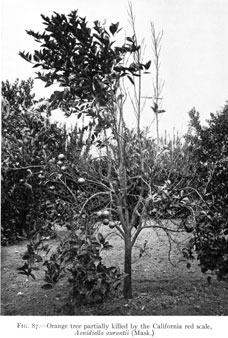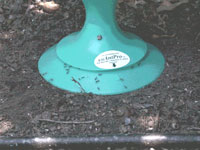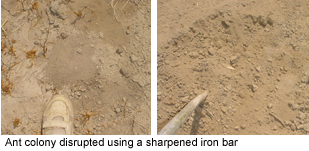Manage Ants to Control Sucking Insects
A nuisance to farmers and picnic goers alike, ants are a much bigger hindrance to an effective biological control program than most people realize. Ant management is often neglected when discussing beneficial insects. Aphids, mealybug, soft scales, and whitefly, among other plant-feeding pests, develop fascinating mutually beneficial relationships with ants and our allies the predators and parasites are not invited. Understanding these relationships will enhance the success of a biological control program.
Certain ants are in the business of farming honeydew-secreting insect pests. They go to great lengths to protect these pests from the beneficials drawn in to eradicate them. Thus, in any well-designed biological control program, ant control is not only cost effective, but necessary. Studies have shown that when ant populations are removed from citrus groves, beneficial insects flourish and pest populations are reduced. Conversely, in situations where ants are present, biological control is impeded, and pest populations flourish.
Always look for ants when you see a pest situation developing and treat the area with boric acid baits or another low risk baiting system. Carry a shovel or pointed tool and disrupt the nests when ants trail on your plants. Damage the tunnels, place some granular bait nearby, then mark the location of the colony for follow up treatment. Light tilling, live and dead mulches, and barriers to food and water are part of an on-going program. Such ant management efforts can keep them suppressed, and with one colony in check you will prevent the establishment of new colonies in the area.
The Big Picture of Ant Dynamics
Ants Farm Aphids
The Planting of One Pest to a Destructive Empire
Proliferation of Secondary Pests Can Destroy Healthy, Mature Trees
Natural Pressures on Ant Colonies
Identifying Ant Species Helps in Selecting the Best Baits
Ant Foraging Behavior Determines Baiting Strategies
Less is Best for Boric Acid in Ant Baits
Triple Jeopardy When Ant Nests are Disrupted
Don't Wait to Put a Shovel into the Nest
Nematodes or Orange Oil Can Knock Down Fire Ant Colonies
Disking, Mulching, and Removing Food and Water are Helpful Strategies
The Big Picture of Ant Dynamics
The individual ant colony functions like an organism in that the queen rules and the various casts of scouts, workers, soldiers, etc. nurture and protect her, laying down their lives for her. Low populations can be tolerated in the refuge areas and plantings. They can create beneficial insectaries that indirectly increase at no charge the resident populations of key predators and parasites by the way the ants enhance the supply of plant-feeding insects. Ants are part of the natural enemy complex that supports biological control. By providing small hot spots of pests they support the resident populations of beneficials that will quickly populate newly planted market crops when pests first start to develop on them. And ants can help assure that there will be predators and parasites in the wings to repopulate the farm or garden after you spray with a soft pesticide. There are wars among colonies and between species. There are natural enemies that attack the ants. Many are species-specific in that there is a different Phorid fly evolved to live on each ant species.
Ants Farm Aphids
Aphids, mealybug, soft scales, and whitefly pests secrete a sugary substance called honeydew, which is very attractive to those few ant species that farm them. Some ants move immature honey-dew secreting pests to favorable sites on a host plant. The pest grows and receives protection against natural enemies. The honeydew-seeking ants, in turn, receive their harvest of honeydew rich in sugars. The pests increase their populations because of the security provided by the ants. As the population increases the ant colony has lots of food and expands producing more queens and young. Before long the area is overpopulated with pests and ants. When plant feeders exude more honeydew than the ants can harvest, the excess begins to cover the plants spreading over the leaves. Black fungi begin to feed on the exudate covering the site with sooty mold. This attracts a broad-spectrum of beneficial insects, which increasingly become a larger part of the ants' diet and supply necessary proteins to match sugars in the honeydew. Ant-infested farm fields are recognizable by the sooty mold on the plants even while driving by in your car. If it is a pesticide salesperson driving by, he may recommend that the farmer start a spray program for whitefly or aphids. The smart farmer does not have to make that decision, because she is managing the ants so they won't hamper the biological controls or make a mess.
The Planting of One Pest to a Destructive Empire
This take-over of ants and sooty mold can begin with just one ant moving one pest individual and tending it until it matures and reproduces and begins secreting its gift of honeydew. The food supply supports more ants resulting in more and more pests, which support more ants and the formation of ant colonies over large areas. The key activists are ant workers, the bucket brigade that always has at least one individual present to protect against the attack of any beneficials, while the others are moving on the trail to and from the nest. Worker ants devour predators and parasites that venture into the pest colony and ant trails. Immature lacewing larvae are especially vulnerable as they approach their attractive insect prey. As the ants fend off and kill lacewing larvae and other predators, they are also destroying the natural biological pest control. This ant interference with biological control extends the length of the ant trail.
Proliferation of Secondary Pests Can Destroy Healthy, Mature Trees
Many secondary pests increase their numbers when large populations of ants interfere with overall biological control. An ant-infested site creates 'hot spots' of a diversity of pests. All pests known to have adequate natural enemies are made worse even though the ants may be focused on only one pest. For example, in citrus trees, where ants may be tending mealybug or black scale, the spider mites and armored California red scale usually increase, too, even though they do not exude honeydew. California red scale will be protected all along the trail of ants as they pass over the trunk. They form a pathway all along gray wood to reach the green wood, leaves and fruit, where the pest infestation flourishes. Ladybugs known as scale destroyers, the Lindorus lophanthae, will compete with the ants and kill these scales through the winter and times when the ants are not active on the trail, and keep the trees from feeding scales. However, where ants are chronic problems, scale and mites on the bark of the trunk and scaffold branches will cause the bark to split and permanently damage the thin living layer of fluid transferring cambium cells beneath the bark, exposing the center wood, and killing the tree. Such ultimate destruction could have been entirely avoided with ant control to protect natural enemies of all of the secondary pests of citrus.

Orange tree devastated by ants protecting CA red scale, from Quayle, 1937
Natural Pressures on Ant Colonies
However grim the battle against ants may seem, there are natural phenomena that do not favor the ants. There is competition between colonies and between species. The activity level varies with species, weather and even the time of day. Many worker ants quit foraging for food and retire to the nest during the heat of the day and return to forage mornings and evenings. The slow speed with which ants move outside the nest while foraging in cool weather results in reduced interference to beneficial predators. Late summer and fall hot weather speeds ant interference. The important point to keep in mind is that when one sees a pest problem developing, don't forget that ant interference may be involved.
Identifying Ant Species Helps in Selecting the Best Bait
Skillful use of ant baits with toxicants is a long-term approach that works. First and foremost, ant species can have vastly different nutritional requirements, so identifying the species can be a key step in choosing suitable bait. For example, Pharaoh worker ants eat more protein while the Argentine workers are omnivorous and tend to prefer sweets. Similarly, while reproducing, Argentine queens eat more protein. In general, the ants that often cause the most problems have the ability to relocate and establish new colonies, (referred to as "Tramp ants"), create large colonies, and require a diet high in sugar. Thus the traditional high-sugar baits designed to mimic honeydew that Tramp ants harvest from the pest insects will be effectively spread throughout a colony in the course of their work.
Ant Foraging Behavior Determines Baiting Strategies
Baits work when the ants are attracted and fooled into carrying a non-lethal amount of toxicant such as boric acid or spinosad to the heart of the nest. There are a number of liquid baits as well as granular baits with different very low-risk and approved for organic toxicants. Gradual accumulation of very small amounts of the toxicant kills the queen and the brood. The whole colony dies. Foraging and nesting behavior is clearly a prime consideration for baiting. The ants should discover the bait as they would during their normal foraging routine. Look around to determine the infestation as well as the location of the nests and runs. Bait stations can then be placed along well-traveled paths and areas near water sources. When bait stations are placed throughout a landscape, it is better not to disrupt the nests by physical means, leaving foragers feeling comfortable to visit bait stations and take the bait. They take some of it and make their way back to the nest. Along the way, they create a pheromone trail for subsequent ants to follow, a trail that leads more ants directly to the newly discovered food laced with the tiny amount of low-risk active pesticide ingredient.

Formica ants coming and leaving a KM AntPro bait
dispenser filled with Gourmet Liquid Ant Bait.
Less is Best for Boric Acid in Ant Baits
When dispensing liquid bait to control ants, such as in the well-engineered, state-of-the-art KM AntPro Bait Dispenser, a common mistake is to add more poison to the bait, in the hope that the extra dose will kill them more quickly. Surprisingly, this has the complete opposite effect. Bait that is too powerful has a two-fold negative effect. First, the foraging ants that are carrying it away from the trap are dying before they reach the colony and are not able to pass the poison on to other members of the colony. Secondly, dead ants around the bait station are a red flag to the ants on their way to pick up more of the new food. The next wave of foraging ants that happen along the dead ants release alarm pheromones to warn the rest of the foragers of the imminent danger. As a result, the rest of the colony stays away from the bait, rendering the bait useless. Service traps regularly to counter effect of evaporation of water from bait, making the poison too strong. When mixing your own bait, it is imperative to stick to a proven recipe. Gourmet Liquid Ant Bait is an easy-to-use commercial bait with the boric acid in the correct amount. See UC trial poster.
Triple Jeopardy when Ant Colonies are Disrupted
A wholesome diet of honeydew and beneficial insects encourages ant populations. The ants quickly produce numerous queens and multiple colonies. In addition to tending to the pests and harvesting the honeydew, the ants may even go to the extent of storing some aphids and scale in the nest and protecting them to start future infestations in the event that a crisis threatens the welfare of the ant colony.

One such crisis to ant colonies is physical disruption by humans. Once the nest has been located, this is a powerful strategy with a three-fold impact on the colony. By destroying the upper level of the nest, the entire colony will turn its efforts on rebuilding. Foragers will not be running the bucket brigade, thus leaving predators and parasites free to clean up the ants' food source. Finally, ants rally to protect their queens and their young and will cannibalize their own young in times of food shortages to benefit survival of the colony. Eventually a new queen is grown and order is restored and foraging resumes.
Don't Wait to Put a Shovel into the Nest
To disrupt a colony use a shovel, digging fork or sharpened 6 foot length of ½ inch rebar to break up the ground around the entrance to the colony. You don't need to dig up the colony, just break up the entry tunnels and nearby chambers. This action is preventative and must be continuously employed. After disruption, granular bait can be sprinkled around the perimeter of the disrupted nest, where some foragers will find the bait and take it back to poison the remainder of the colony.
Nematodes or Orange Oil Good for Knocking Down Fire Ant Colonies
Alternately you can treat hard to access colonies and those of biting ants that might be unpleasant to disrupt with insect eating nematodes, Steinernema carpocapse or Heterorhabditis indica. The latter has shown good results on fire ant colonies both through mound treatment and broadcast application. Orange oil mixed 4 to 6 ounces with 2 ounces of soap or detergent per gallon applied 1 to 4 quarts per colony also knocks back a colony.
Disking, Mulching, Removing Food and Water-Helpful Cultural Strategies
Ants generally prefer to build colonies in warm, dry, undisturbed sites. Periodically disking adjacent roads that harbor ant nests can alone disrupt the ant interference long enough to allow biological control organisms to subdue pests. Covering the soil along roads or paths with insect attracting plants decreases soil temperature and makes it less attractive for most problem ants. Insectary plants also help suppress weeds and draw beneficial insects to help with biocontrol. Similarly, mulching is a good method of discouraging ants as it increases moisture and decreases soil temperature. Ants will inhabit areas where food and water are readily available, so by limiting access to water and sugar, and isolating leaks or openings that would make these accessible, ant infestations will be discouraged. When searching for the nests, look closely at irrigation lines that offer easy access to ant colonies. Drip irrigation lines offer pathways and access to water.
|

